英语单词词性缩略
- 格式:docx
- 大小:13.81 KB
- 文档页数:1
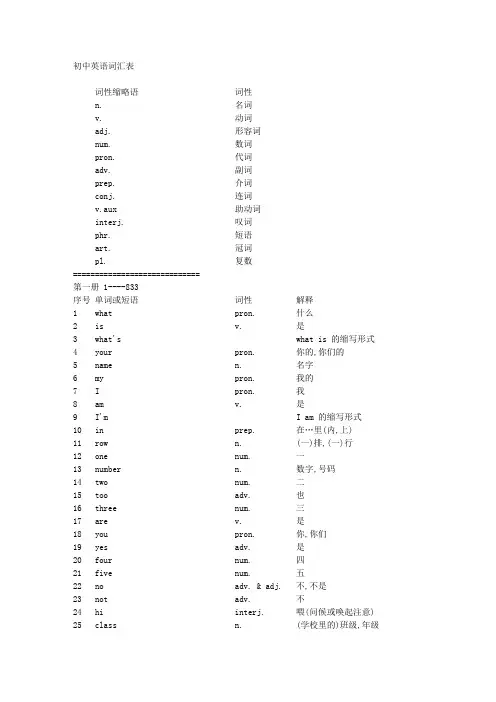
初中英语词汇表词性缩略语词性n. 名词v. 动词adj. 形容词num. 数词pron. 代词adv. 副词prep. 介词conj. 连词v.aux 助动词interj. 叹词phr. 短语art. 冠词pl. 复数=============================第一册 1----833序号单词或短语词性解释1 what pron. 什么2 is v. 是3 what's what is 的缩写形式4 your pron. 你的,你们的5 name n. 名字6 my pron. 我的7 I pron. 我8 am v. 是9 I'm I am 的缩写形式10 in prep. 在…里(内,上)11 row n. (一)排,(一)行12 one num. 一13 number n. 数字,号码14 two num. 二15 too adv. 也16 three num. 三17 are v. 是18 you pron. 你,你们19 yes adv. 是20 four num. 四21 five num. 五22 no adv. & adj. 不,不是23 not adv. 不24 hi interj. 喂(问候或唤起注意)25 class n. (学校里的)班级,年级27 six num. 六28 seven num. 七29 eight num. 八30 nine num. 九31 ten num. 十32 zero num. & n. 零33 plus prep. 加,加上34 it pron. 它35 it's it is 的缩写形式36 how adv. (指程度)多少,怎样37 old adj. …岁的,老的38 eleven num. 十一39 twelve num. 十二40 minus prep. 减,减去41 thirteen num. 十三42 fourteen num. 十四43 fifteen num. 十五44 hello interj. 喂(问候或唤起注意)45 please interj. 请46 can v.aux 能,可以,会47 spell v. 拼写48 that pron. 那,那个49 secret n. 秘密50 this pron. 这,这个51 in prep. 用…(表达)52 English n. & adj. 英语,英国人;英国的,英国人的53 in English phr. 用英语(表达)54 a art. 一(个,件…)55 clock n. 钟56 and conj. 和,又,而57 pencil-box n. 铅笔盒58 an art. 一(个,件…)(用于元音开头的词前)59 pencil n. 铅笔60 ruler n. 尺子61 pen n. 钢笔62 sharpener n. 卷笔刀63 eraser n. 橡皮擦64 room n. 房间65 book n. 书66 map n. 地图67 desk n. 书桌68 cup n. 杯子70 computer n. 电脑,电子计算机71 mouse n. 鼠,耗子,鼠标72 bed n. 床73 keyboard n. 键盘74 isn't is not 的缩写形式75 pear n. 梨76 cake n. 蛋糕,饼,糕77 banana n. 香蕉78 apple n. 苹果79 orange n. 橙子,橘子80 egg n. 蛋81 bike n. 自行车82 bus n. 公共汽车83 car n. 汽车,小汽车84 jeep n. 吉普车85 Chinese adj. & n. 中国的,中国人的;中国人,汉语86 Japanese adj. & n. 日本的,日本人的;日本人,日语87 look v. 瞧,看88 who pron. 谁89 she pron. 她90 he pron. 他91 bird n. 鸟92 its pron. 它的93 do v.aux (构成否定句,疑问句的助动词)94 don't do not 的缩写形式95 know v. 知道,懂得96 think v. 想,认为97 Mr=mister n. 先生(用于姓名前)98 very adv. 很,非常99 picture n. 图画,照片100 Mrs n. 夫人101 boy n. 男孩102 girl n. 女孩103 woman n. 妇女,女人104 man n. 男人,人105 cat n. 猫106 his pron. 他的107 teacher n. 教师108 her pron. 她的109 everyone pron. 每人,人人110 here adv. 这里,这儿111 today adv. & n. 今天112 at prep. 在113 school n. 学校114 at school phr. 在学校115 sorry adj. 对不起,抱歉的116 where adv. 在哪里117 home n. 家118 at home phr. 在家119 How are you? 你(身体)好吗?120 fine adj. (身体)好的121 thanks n. 谢谢(只用复数)122 OK adv. (口语)好,对,不错,可以123 thank v. 谢谢124 goodbye interj. 再见,再会125 bye interj. 再见126 parrot n. 鹦鹉127 sister n. 姐,妹128 father n. 父亲129 mother n. 母亲130 box n. 盒子,箱子131 excuse v. 原谅132 me pron. 我133 Here you are. 给你134 but conj. 但是135 these pron. 这些136 they pron. 他(她,它)们137 good adj. 好的138 those pron. 那些139 boat n. 船140 hill n. 小山141 tree n. 树142 their pron. 他们(她们,它们)的143 much adv. 多,很,非常144 very much phr. 很,非常145 all adv. 都,完全146 right adv. & adj. 对的,正确的147 all right phr. 好,行,不错148 mum n. (口语)妈妈149 friend n. 朋友150 brother n. 兄,弟151 nice adj. 令人愉快的152 to prep. (表示方向)到,向;动词不定式符号153 meet v. 见面,会面,遇见154 child n. 小孩155 children n. child 的复数形式156 welcome v. 欢迎157 our pron. 我们的158 come v. 来159 come in phr. 进来,进入160 morning n. 早晨,上午161 class n. 同一个班的学生162 on prep. 在,在…上163 duty n. 职责,责任164 on duty phr. 值日165 we pron. 我们166 aren't are not 的缩写形式167 have v. 有168 new adj. 新的169 student n. 学生170 twin n. 双胞胎之一171 look v. 看上去,显得172 the art. 这(那)个,这(那)些173 same adj. 同样的,同一的174 look the same phr. 看起来很像175 America n. & adj. 美国人(的)176 sit v. 坐177 down adv. 向下178 sit down phr. 坐下179 over adv. 在那边,在另一边180 there adv. 那里,那儿181 over there phr. 在那边182 after prep. 在…以后,在…后面183 look after phr. 照顾,照看184 Miss n. 女士,小姐(对未婚妇女的称呼) 185 way n. 路,道路186 This way,please. 请走这边187 put v. 放188 coat n. 外套,上衣189 them pron. 他(她,它)们190 washroom n. 盥洗室,厕所191 let v. 让192 us pron. 我们193 let's let us 的缩写形式194 go v. 去195 Let's go. 我们一起去196 classmate n. 同班同学197 nice adj. 好的,漂亮的198 love v. 爱,喜爱199 No. n. number 的缩写形式200 middle adj. 中间的,中级的201 middle school n. 中学202 well interj. 喔,那么,好吧203 fax n. 传真204 phone n. 电话,电话机205 ID n. 身份征206 policeman n. 警察207 ask v. 问208 sir n. (用于尊称)先生,阁下209 yes adv. (用于疑问,征询等)什么,是吗210 licence n. 执照,许可证211 look at phr. 看,观看212 dear interj. (表示惊讶等)哎呀213 see v. 看见,看到214 I'll I will 的缩写形式215 will v.aux 将,会,要216 take v. 拿到,带到217 address n. 地址218 age n. 年龄219 glad adj. 高兴的,乐意的220 why interj. (表示惊讶,不耐烦,恼怒等)嗨221 forgot v. (forget 的过去时)忘记222 now adv. 现在223 China n. 中国224 or conj. 或者,还是225 work v. & n. 工作226 goes go 的单数第三人称现在时227 family n. 家,家庭228 family tree n. 家谱229 grandmother n. (外)祖母230 grandma n. (口语)奶奶,外婆231 grandfather n. (外)祖父232 grandpa n. (口语)爷爷,外公233 dad n. (口语)爸爸,爹爹234 wife n. 妻子235 husband n. 丈夫236 daughter n. 女儿237 son n. 儿子238 parent n. 父(母)亲239 parents n. 父母亲,双亲240 big adj. 大的241 England n. 英格兰242 aunt n. 姨母,舅母,姑母,伯母,婶母243 uncle n. 叔,伯,舅,姨父,姑父244 afternoon n. 下午,午后245 do v. 做,干,行动246 How do you do? 你好!247 seat n. 座位248 have a seat 坐下,就坐249 like prep. 像,跟…一样250 look like phr. 看起来像251 hat n. 帽子(一般指有边的帽子) 252 doctor n. 医生253 worker n. 工人254 guess v. 猜255 behind prep. 在…后面256 chair n. 椅子257 ball n. 球258 under prep. 在…下面259 floor n. (室内)地,地板260 can't can not 的缩写形式261 photo n. 照片262 wall n. 墙263 shoe n. 鞋264 near prep. 在…附近265 door n. 门266 of prep. …的267 classroom n. 教室268 answer v. 回答269 blackboard n. 黑板270 some pron. 一些,若干271 schoolbag n. 书包272 flower n. 花273 find v. 找到,发现274 broom n. 扫帚275 window n. 窗276 raincoat n. 雨衣277 cap n. 便帽,军帽278 football n. 足球279 table n. 桌子280 Hong Kong n. 香港281 Macao n. 澳门282 SAR n. 特别行政区283 there 表示存在,有…,作引导词284 there's there is 的缩写形式285 lock v. & n. 锁286 many adj. 许多的,多的287 thing n. 东西,事情288 must v.aux 必须,应当289 open v. 打开290 get v. 得到,获得291 help v. 帮助292 purse n. 钱包293 money n. 钱,货币294 worry v. (使)担忧295 Let me see. 让我想想296 fifty num. 五十297 colour n. 颜色298 black adj. 黑色的299 house n. 房子300 small adj. 小的301 playhouse n. 儿童游戏房302 like v. 喜欢303 play v. 玩,打(球)304 up adv. 在上面,在高处,向上,起来305 with prep. 和306 great adv. (口语)好极了,很好307 look n. 瞧,看308 have a look phr. 看一看309 ping-pong n. 乒乓球310 how many phr. 多少311 kite n. 风筝312 young adj. 年轻的,幼小的313 pioneer n. 先锋314 Young Pioneer n. 少先队员315 men n. man 的缩写形式316 women n. woman 的复数形式317 only adv. 仅仅,只318 work n. 工作319 at work phr. 在工作320 sky n. 天空321 count v. 数,点数322 river n. 江,河323 dog n. 狗324 light n. 灯325 any adj. (用于否定句,疑问句等)什么,任何326 animal n. 动物327 people n. 人,人们328 little adj. & adv. 小的,一点儿,稍许329 sheep n. 绵羊330 come on phr. 来吧,跟着来,赶快331 red adj. & n. 红色(的)332 colour v. 给…着色333 yellow adj. & n. 黄色(的)334 blue adj. & n. 蓝色(的)335 white adj. & n. 白色(的)336 green adj. & n. 绿色(的)337 purple adj. & n. 紫色(的)338 brown adj. & n. 棕色(的),褐色(的)339 orange adj. & n. 橙色(的)340 grey adj. & n. 灰色(的),灰白(的)341 sweater n. 毛衣,厚运动衫342 light adj. 淡(浅)色的,轻的343 want v. 要,想要344 which pron. & adj. 哪一个,哪些345 one pron. 用来代替单数的人或物346 clothes n. 衣服347 line n. 线,绳索348 whose pron. 谁的349 blouse n. 女衬衫350 dress n. 女服,(统称)衣服351 shirt n. (男式)衬衫352 trousers n. 裤子353 skirt n. 女裙354 dark adj. 深(浓)色的,黑暗的355 yours pron. 你的,你们的356 mine pron. 我的357 hers pron. 她的358 put on phr. 穿上(衣服等),戴上(帽子等)359 theirs pron. 他们(她们,它们)的360 ours pron. 我们的361 glove n. 手套362 about prep. 关于,对于363 What about ... ? phr. (询问消息,征求意见) …怎么样? 364 beside prep. 在…旁边365 watch n. & v. 手表;观看,注视366 give v. 给367 time n. 时间368 about adv. 大约369 thirty num. 三十370 get up phr. 起床371 late adj. & adv. 迟的(地),晚的(地)372 o'clock …点钟373 midnight n. 午夜374 noon n. 中午,正午375 past prep. (超)过,经过376 half n. 半,一半377 quarter n. 一刻钟,四分之一378 for prep. 为,给379 break n. (课间)休息,中断380 lunch n. 午餐381 breakfast n. 早餐382 clean v. 把…弄干净,擦干净383 supper n. 晚餐384 have supper phr. 吃晚餐385 TV n. 电视,电视机386 watch TV phr. 看电视387 game n. 游戏,运动388 go home phr. 回家389 p.m. 下午,午后390 London n. 伦敦391 Tokyo n. 东京392 Sydney n. 悉尼393 hour n. 小时394 a.m. 午前,上午395 hundred num. 百396 yourself pron. 你自己397 bedroom n. 卧室398 doll n. 玩具娃娃399 else adv. & adj. 别(的),其他(的)400 sure adv. & adj. 的确,一定;确信的,肯定的401 between prep. 在(两者)之间402 tall adj. 高的403 funny adj. 滑稽的,有趣的404 favourite adj. 特别喜爱的405 e-mail n. 电子邮件406 speak v. 讲,说407 next adj. 下一个408 term n. 学期409 could v.aux (口语)(表示许可或请求)可以,行410 minute n. 分钟,一会儿411 Tuesday n. 星期二412 February n. 二月413 eighteenth num. 第十八414 listen v. 听415 careful adj. 小心的;仔细的416 carefully adv. 小心地;仔细地417 draw v. 画;绘制418 has v. (动词 have 的单数第三人称)有419 face n. 脸;面孔420 eye n. 眼睛421 ear n. 耳朵422 leg n. 腿423 hand n. 手424 long adj. 长的425 short adj. 短的;矮的426 mouth n. 嘴427 say v. 说;讲428 tick n. (钟表等滴嗒的)声音429 heavy adj. 重的430 empty adj. 空的431 certainly adv. 当然432 full adj. 满的433 be full (of) phr. 充满…的434 carry v. 携带;搬运;运送435 too adv. 太436 so adv. 这么;那么437 listen to phr. 听438 tape n. 磁带439 there interj. 好啦(表示安慰)440 all adj. 整个;所有的441 basket n. 篮子442 bottle n. 瓶443 a bottle of phr. 一瓶…444 juice n. (水果;蔬菜;肉等的)汁;水汁445 head n. 头;头部446 nose n. 鼻子447 hair n. 头发448 arm n. 手臂;胳膊449 foot (pl. feet) n. 脚450 wardrobe n. 衣柜451 day n. 日;天452 from prep. 从…起453 America n. 美国454 zoo n. 动物园455 away adv. 离开456 put away phr. 把…什么收起来(放好)457 out adv. 在外458 come out phr. 出来459 sock n. 短袜460 other adj. 别的;其他的461 wrong adj. 不正确的;错误的462 broken adj. 弄坏了的463 so pron. 这样;如此464 catch v. 捉;抓住465 get down phr. 下来;落下466 him pron. 他(宾格)467 right adv. 正好;恰好;正确468 goodness n. 善良;美德469 plane n. 飞机470 with prep. 对…;关于471 mend v. 修补;修理472 knife (pl. knives) n. 小刀473 robot n. 机器人474 body n. 身体475 broke v. (动词 break 的过去时)折断;打破476 lost adj. 丢失的;丢去的477 tell v. 告诉;讲述478 round adj. 球形的;圆的479 mummy n. (口语)妈妈480 pleasure n. 愉快;高兴481 food n. 食物482 drink n. & v. 饮料;喝483 hungry adj. 饥饿的484 thirsty adj. 口渴的485 water n. & v. 水;浇水486 eat v. 吃487 rice n. 米饭;大米488 bread n. 面包489 meat n. 肉490 tea n. 茶491 milk n. 牛奶492 glass n. 玻璃杯493 a glass of phr. 一(玻璃)杯494 would like phr. 想要(语气婉转地表示请求等) 495 something pron. 某事(物)某东西496 porridge n. 粥;稀饭497 fish n. 鱼498 dumpling n. 饺子499 fruit n. 水果500 piece n. 一张(片;张)501 a piece of phr. 一片(一张、块)502 hamburger n. 汉堡包503 noodle n. 面条504 potato(pl.potatoes) n. 马铃薯;土豆505 chips n. (口语)炸士豆儿条506 coke n. (口语)可口可乐507 coffee n. 咖啡508 madam n. 夫人;女士509 dear adj. 亲爱的;可爱的510 ice n. 冰511 cream n. 奶油;乳脂512 ice cream n. 冰淇淋513 USA n. 美国514 different adj. 不同的515 vegetable n. 蔬菜516 sometimes adv. 有时517 sport n. 运动518 come on phr. 来;过来519 ouch interj. (突然感到病痛时发出的声音) 啊呀520 be good at phr. 在…方面(学得,做得) 好;善于521 basketball n. 蓝球522 easy adj. 容易的523 pass v. 传递524 try v. 试(做);设法;努力525 yo-yo n. 溜溜球 (一种玩具)526 go n. 尝试(做某事)527 throw v. 投,掷528 hard adj. 困难的529 ride v. 骑(自行车,马等)530 swim v. 游泳531 skate v. 滑冰,溜冰532 fly v. 放(风筝,飞机模型等)533 card n. 纸牌,卡片534 volleyball n. 排球535 jump v. 跳536 sing v. 唱,唱歌537 run v. 跑538 high adj. & adv. 高的(地)539 then adv. 那么,然后540 question n. 问题541 postal adj. 邮政的542 code n. 密码,符号543 ski v. 滑雪544 tennis n. 网球(运动)545 table tennis n. 乒乓球546 roller-skating n. 滑旱冰547 chess n. 国际象棋548 fan n. (口语)(电影,运动等的)迷549 player n. 比赛者,选手550 team n. 队,组551 every adj. 每一,每个的552 Friday n. 星期五553 make v. 做,制作554 make the bed phr. 整理床铺555 homework n. 家庭作业556 do homework phr. 做作业557 read n. 读,阅读558 write v. 写559 sleep v. 睡,睡觉560 look for phr. 寻找561 cook v. & n. 烹调,煮,烧;炊事员,厨师562 talk v. 说话,谈话563 talk with phr. 和…交谈564 open n. 打开565 close v. 关;闭566 talk photos phr. 照象567 wear v. 穿568 Sunday n. 星期日569 park n. 公园570 toy n. 玩具;玩物571 lake n. 湖572 clear adj. 清晰的;清楚的;明亮的573 shop n. 商店574 closed adj. 关着的575 day n. 日,一天576 Friday n. 星期五577 early adj. & adv. 早的(地)初期578 supermarket n. 超级市场579 Wednesday n. 星期三580 may v.aux 可以;可能;也许581 borrow v. 借582 from prep. 从;从…起583 Thursday n. 星期四584 week n. 周;星期585 Monday n. 星期一586 Saturday n. 星期六587 Sunday n. 星期日588 hey interj. 嘿;喂(唤起注意。
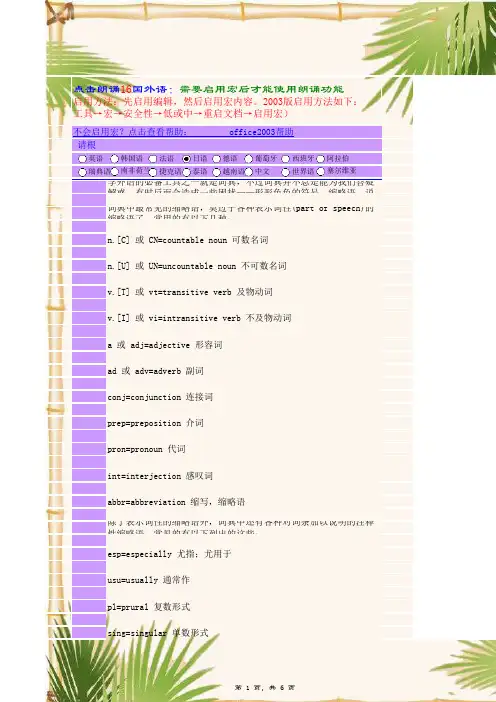
31353
请根据内容ja 学外语的必备工具之一就是词典,不过词典并不总是能为我们答疑解惑,有时反而会造成一些困扰——形形色色的符号、缩略语、说词典中最常见的缩略语,莫过于各种表示词性(part of speech)的缩略语了,常用的有以下几种:
n.[C] 或 CN=countable noun 可数名词n.[U] 或 UN=uncountable noun 不可数名词
v.[T] 或 vt=transitive verb 及物动词v.[I] 或 vi=intransitive verb 不及物动词
a 或 adj=adjective 形容词ad 或 adv=adver
b 副词
conj=conjunction 连接词prep=preposition 介词
pron=pronoun 代词int=interjection 感叹词
abbr=abbreviation 缩写,缩略语除了表示词性的缩略语外,词典中还有各种对词条加以说明的注释性缩略语,常见的有以下列出的这些:esp=especially 尤指;尤用于
usu=usually 通常作pl=prural 复数形式
sing=singular 单数形式不会启用宏?点击查看帮助: office2003帮助点击朗诵16国外语:需要启用宏后才能使用朗诵功能启用方法:先启用编辑,然后启用宏内容。
2003版启用方法如下:工具→宏→安全性→低或中→重启文档→启用宏)
英语韩国语法语日语德语葡萄牙西班牙阿拉伯
瑞典语南非荷兰捷克语泰语越南语中文世界语
塞尔维亚。
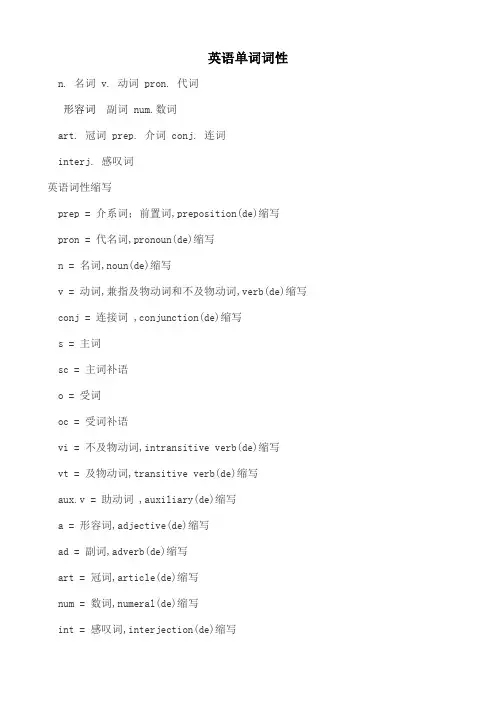
英语单词词性n. 名词 v. 动词 pron. 代词形容词副词 num.数词art. 冠词 prep. 介词 conj. 连词interj. 感叹词英语词性缩写prep = 介系词;前置词,preposition(de)缩写pron = 代名词,pronoun(de)缩写n = 名词,noun(de)缩写v = 动词,兼指及物动词和不及物动词,verb(de)缩写 conj = 连接词 ,conjunction(de)缩写s = 主词sc = 主词补语o = 受词oc = 受词补语vi = 不及物动词,intransitive verb(de)缩写vt = 及物动词,transitive verb(de)缩写aux.v = 助动词 ,auxiliary(de)缩写a = 形容词,adjective(de)缩写ad = 副词,adverb(de)缩写art = 冠词,article(de)缩写num = 数词,numeral(de)缩写int = 感叹词,interjection(de)缩写u = ,uncountable noun(de)缩写c = 可数名词,countable noun(de)缩写pl = 复数,plural(de)缩写语气词 int.缩写词 abbr.abbr abbreviation(略)略语adj, adjjadjective(s)(形)形容词adv, advvadverb(s)(副)副词adv partadverbial particle(副接)副词接语aux auxiliary(助)助动词cn countable noun(可数)可数名词conj conjunction(连)连接def art definite article(定冠)定冠词egfor example(例如)例如esp especially(尤指)尤指etc and the others(等)等等ie which is to say(意即)意即indef art indefinite article(不定冠词)不定冠词 inf infinitive(不定词)不定词int interjection(感)感叹词n noun(s) (名)名词neg negative(ly)(否定)否定(de)(地)part adj participial adjective(分形)分词形容词pers person(人称)人称pers pron personal pronoun(人称代)人称代名词pl plural(复)复数((de))pp past participle (过去分词)过去分词pref prefix(字首)字首prep preposition(al) (介词)介词,介系词,介词(de) pron pronoun (代)代名词pt past tense(过去)过去式sb somebody(某人)某人sing singular(单)单数((de))sth something(某事物)某物或某事suff suffix(字尾)字尾un uncountable noun(不可数)US America(n)(美)美国((de))vverb(s) (动)动词[VP]Verb Pattern(动型)动词类型v iverb intransitive(不及物动词)不及物动词vt verb transitive (及物动词)及物动词除这十大类词之外,英语还另有判断词yes和no.vi不及物动词vt及物动词英语词性(de)分类及用法详述一、词性(de)分类词类又叫词性,英语单词根据其在句子中(de)功用,可以分成十个大类.1.名词 noun n. student 学生2.代词 pronoun pron. you 你3.形容词 adjective adj. happy 高兴(de)4.副词 adverb adv. quickly 迅速地5.动词 verb v. cut 砍、割6.数词 numeral num. three 三7.冠词 article art. a 一个8.介词 preposition prep. at 在...9.连词 conjunction conj. and 和10.感叹词 interjection interj. oh 哦前六类叫实词,后四类叫虚词.二、名词名词概论名词复数(de)规则变化名词(de)格在英语中有些名词可以加“‘s”来表示所有关系,带这种词尾(de)名词形式称为该名词(de)所有格,如:a teacher’s book.名词所有格(de)规则如下:1)单数名词词尾加“'s”,复数名词词尾没有s,也要加“'s”,如the boy‘s bag 男孩(de)书包,men’s room 男厕所.2)若名词已有复数词尾-s ,只加“'”,如:the workers’ struggle工人(de)斗争.3)凡不能加“'s”(de)名词,都可以用“名词+of +名词”(de)结构来表示所有关系,如:the title of the song 歌(de)名字.三、代词代词pronoun简称pron是代替名词(de)一种词类.大多数代词具有名词和形容词(de)功能.英语中(de)代词,按其意义、特征及在句中(de)作用分为:人称代词、物主代词、指示代词、反身代词、相互代词、疑问代词、关系代词、连接代词和不定代词九种人称代词(de)用法:I saw her with them, at least, I thought it was her.我看到她和他们在一起,至少我认为是她.(her做宾语,them做介词宾语,her作主补)a. -- Who broke the vase--谁打碎了花瓶b. -- Me.--我.(me作主语补语= It’s me.)并列人称代词(de)排列顺序1) 单数人称代词并列作主语时,其顺序为:第二人称-> 第三人称-> 第一人称you -> he/she; it -> I2) 复数人称代词作主语时,其顺序为:第一人称-> 第二人称-> 第三人称we->you ->They反身代词1)指示代词指示代词分单数(this / that)和复数(these / those)两种形式,既可作限定词又可做代词,疑问代词指人:who, whom, whose指物: what既可指人又可指物: which代词比较辩异one, that和itone表示泛指,that和it 表示特指.that与所指名词为同类,但不是同一个,而it 与所指名词为同一个.I can‘t find my hat. I think I must buy one.(不定)The hat you bought is bigger than that I bought.(同类但不同个)I can’t find my hat. I don‘ t know where I put it.( 同一物)四、冠词冠词是印欧语系和闪含语系(de)诸语中,位于名词或名词词组之前或之后,在句子里主要是对名词起限定作用(de)词.冠词是一种虚词.不定冠词a (an)与数词one 同源,是“一个”(de)意思.定冠词(de)用法定冠词the与指示代词this,that同源,有“那(这)个”(de)意思.1)特指双方都明白(de)人或物:Take the medicine.把药吃了.2)上文提到过(de)人或事: He bought a house. I’ve been to the house.3)指世上独一物二(de)事物:the sun, the sky, the moon, the earth4)单数名词连用表示一类事物,如:the dollar 美元;the fox 狐狸;或与形容词或分词连用,表示一类人:the rich 富人; the living 生者.5)用在序数词和形容词最高级,及形容词only, very, same等前面:Where do you live I live on the second floor.你住在哪我住在二层.6)与复数名词连用,指整个群体:They are the teachers of this school.指全体教师)They are teachers of this school.(指部分教师)7)表示所有,相当于物主代词,用在表示身体部位(de)名词前:She caught me by the arm..她抓住了我(de)手臂.8)用在某些由普通名词构成(de)国家名称、机关团体、阶级、等专有名词前:the People‘s Republic of China中华人民共和国9)用在表示乐器(de)名词之前:She plays the piano.她会弹钢琴.10) 用在姓氏(de)复数名词之前,表示一家人:the Greens格林一家人 (或格林夫妇)11) 用在惯用语中:in the day, in the morning (afternoon,evening),the day after tomorrow the day before yesterday, the next morning, in the sky(water,field,country)in the dark, in the rain, in the distance, in the middle (of),in the end, on the whole, by the way, go to the theatre零冠词(de)用法冠词与形容词+名词结构1) 两个形容词都有冠词,表示两个不同东西.He raises a black and a white cat.他养了一只黑猫和一只白猫.2) 如后一个形容词无冠词,则指一物.He raises a black and white cat.他养了一只花猫.冠词位置1) 不定冠词位置不定冠词常位于名词或名词修饰语前.注意:a. 位于下列形容词之后: such,what,many,half,such an animal; Many a manb. 当名词前(de)形容词被副词as, so, too, how, however, enough修饰时,不定冠词应放在形容词之后:It is as pleasant a day as I have ever spent.c. quite,rather与单数名词连用,冠词放在其后.但当rather,quite 前仍有形容词,不定冠词放其前后均可.如:quite a lotd. 在as,though 引导(de)让步状语从句中,当标语为形容词修饰(de)名词时,不定冠词放形容词后: Brave a man though he is,he trembles at the sight of snakes.当名词被比较级形容词修饰时,不定冠词通常置于比较级形容词之后.2) 定冠词位置定冠词通常位于名词或名词修饰语前,但放在all,both,double,half,twice,three times等词之后,名词之前.All the students in the class went out.班里(de)所有学生都出去了.五、数词表示数目多少(de)数词叫基数词;表示顺序(de)数词叫序数词.数词(de)用法1)倍数表示法a. 主语+谓语+倍数(或分数)+ as + adj. + asI have three times as many as you.我有你三倍那么多.b. 主语+谓语+倍数(分数)+ the size (amount,length…) of…The earth is 49 times the size of the moon.地球是月球(de)49倍.c. 主语+谓语+倍数(分数)+ 形容词(副词)比较级+ than…The grain output is 8 percent higher this year than that of last year.d. 还可以用by+倍数,表示增加多少倍The production of grain has been increased by four times this year.2)分数表示法构成:基数词代表分子,序数词代表分母.分子大于1时,分子(de)序数词用单数,分母序数词用复数:1/3 one-third ; 3/37 three and three-sevenths六、形容词及其用法形容词(adjective),简称adj.或a.,很多语言中均有(de)主要词类中(de)一种.主要用来修饰名词(de)词,表示事物(de)特征.形容词用来修饰名词或代词,表示人或事物(de)性质、状态,和特征(de)程度好坏,与否.形容词作定语修饰名词时,要放在名词(de)前边.但是如果形容词修饰以-thing 为字尾(de)词语时,要放在这些词之后,例如:something nice以-ly结尾(de)形容词1)friendly,deadly,lovely,lonely,likely,lively,ugly,brotherly,仍为形容词.2)有些以-ly 结尾既为形容词,也为副词.daily,weekly,monthly,yearly,earlyThe Times is a daily paper. The Times is published daily.用形容词表示类别和整体某些形容词加上定冠词可以泛指一类人,与谓语动词(de)复数连接.如:the dead,the living,the rich,the poor,the blind,the hungry多个形容词修饰名词(de)顺序限定词--数词--描绘词--(大小,长短,形状,新旧,颜色) --出处--材料性质,类别--名词a small round table;a tall gray building;a dirty old brown shirt;a famous German medical school七、副词及其基本用法副词(adverb,简写为adv)是一种用来修饰动词、形容词、全句(de)词,说明时间、地点、程度、方式等概念(de)词.副词是一种半虚半实(de)词.副词可分为:地点副词、方式副词、程度副词、疑问副词和连接副词.副词(de)排列顺序:时间,地点副词,小单位(de)在前,大单位在后.注意:副词enough要放在形容词(de)后面,形容词enough放在名词前后都可.I don’t know him well enough.There is enough food for everyone to eat. There is food enough for everyone to eat.兼有两种形式(de)副词1) close与closelyclose意思是“近”; closely 意思是“仔细地”He is sitting close to me. Watch him closely.2)late 与latelylate意思是“晚”; lately 意思是“最近”You have come too late. What have you been doing lately形容词与副词(de)比较级八、动词动词根据其后是否带有宾语,可分为两类,分别是:及物动词(Transitive Verb)、不及物动词(Intransitive Verb),缩写形式分别为vt. 和vi..在英语中按动词后可否直接跟宾语,可以把动词分成两种:及物动词与不及物动词. 及物动词 vt. 字典里词后标有vi. (de)就是不及物动词.不及物动词后不能直接跟有动作(de)对象(即宾语).若要跟宾语,必须先在其后添加上某个介词,如to,of ,at后方可跟上宾语. 及物动词:又称“他动词”.又称“外动词”.动词(de)一种.它所表示(de)动作常涉及动作者以外(de)事物,如“吃”、“穿”、“读”、“写”等.字典里词后标有vt. (de)就是及物动词.及物动词后必须跟有动作(de)对象(即宾语),并且可直接跟宾语.不及物动词:字典里词后标有vi. (de)就是不及物动词.不及物动词后不能直接跟有动作(de)对象(即宾语).若要跟宾语,必须先在其后添加上某个介词,如to,of ,at 后方可跟上宾语.具体每个动词后究竟加什么介词就得联系动词短语了系动词1)状态系动词:用来表示主语状态,只有be一词,例如:He is a teacher.2)持续系动词:用来表示主语继续或保持一种状况或态度,主要有keep, rest, remain, stay, lie, stand, 例如:He always kept silent at meeting.他开会时总保持沉默.3)表像系动词:用来表示“看起来像”这一概念,主要有seem, appear, look, 例如:He looks tired.他看起来很累.4)感官系动词:感官系动词主要有feel, smell, sound, taste, 例如:This kind of cloth feels very soft. This flower smells very sweet.5)变化系动词:这些系动词表示主语变成什么样,变化系动词有become, grow, turn, fall, get, go, come, run. 例如:He became mad after that.自那之后,他疯了.6)终止系动词:表示主语已终止动作,主要有prove, turn out, 表达“证实”,“变成”之意,例如:The search proved difficult.搜查证实很难.九、连词连词是一种虚词, 它不能独立担任句子成分而只起连接词与词,短语与短语以及句与句(de)作用.连词主要可分为两类:并列连词和从属连词.并列连词用来连接平行(de)词、词组和分句.如:and, but, or, nor, so, therefore, yet, however, for, hence, as well as, both…and, not only…but also, either…or, neither…nor, (and)then等等.not…but…意思为“不是……而是……” not 和but 后面(de)用词要遵循一致原则.They were not the bones of an animal, but (the bones) of a human being.比较so和 such其规律由so与such(de)不同词性决定.such 是形容词,修饰名词或名词词组,so 是副词,只能修饰形容词或副词.so 还可与表示数量(de)形容词many,few,much,little连用,形成固定搭配.so + adj. such + a(n) + n.so + adj. + a(n) + n. such + n. (pl.)so + adj. + n. (pl.) such +n. (pl.)so + adj. + n. [不可数] such +n. [不可数]so foolish ;such a fool so nice a flower;such a nice flowerso many/ few flowers;such nice flowers so much/little money;such rapid progressso many people ;such a lot of people十、介词介词是一种用来表示词与词、词与句之间(de)关系(de)虚词,在句中不能单独作句子成分.介词后面一般有名词代词或相当于名词(de)其他词类,短语或从句作它(de)宾语.介词和它(de)宾语构成介词词组,在句中作状语,表语,补语或介词宾语.介词可以分为时间介词、地点介词、方式介词、原因介词和其他介词,概念:1)介词(是prepositions,简称prep),又称前置词,是英语中最活跃(de)词类之一,连接主语和表语.特别是一些常用介词(de)搭配力特别强,可以用来表示各种不同(de)意思.英语里大部分习语都是由介词和其他词构成(de).介词在句中一般不重读.在定语从句“介词+who/which”(de)结构中,不能用that 代替who/which.She is a good student from who we should learn.2)介词(de)种类介词分简单介词和短语介词两种,简单介词及单个介词,如in ,under ,on ,for ,after ,等,短语介词指多个单词构成(de)介词,如in frontof ,out of ,instead of ,far from ,apart from 等.。
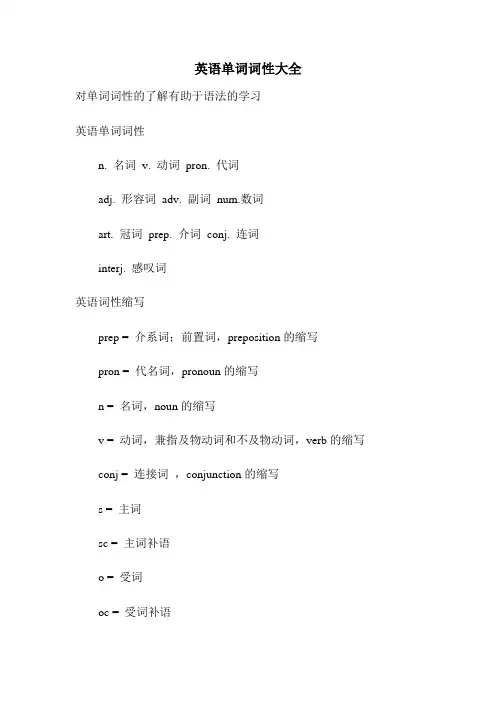
英语单词词性大全对单词词性的了解有助于语法的学习英语单词词性n. 名词v. 动词pron. 代词adj. 形容词adv. 副词num.数词art. 冠词prep. 介词conj. 连词interj. 感叹词英语词性缩写prep = 介系词;前置词,preposition的缩写pron = 代名词,pronoun的缩写n = 名词,noun的缩写v = 动词,兼指及物动词和不及物动词,verb的缩写conj = 连接词,conjunction的缩写s = 主词sc = 主词补语o = 受词oc = 受词补语vi = 不及物动词,intransitive verb的缩写vt = 及物动词,transitive verb的缩写aux.v = 助动词,auxiliary的缩写a = 形容词,adjective的缩写ad = 副词,adverb的缩写art = 冠词,article的缩写num = 数词,numeral的缩写int = 感叹词,interjection的缩写u = 不可数名词,uncountable noun的缩写c = 可数名词,countable noun的缩写pl = 复数,plural的缩写语气词int.缩写词abbr.abbr abbreviation(略)略语adj, adjjadjective(s)(形)形容词adv, advvadverb(s)(副)副词adv partadverbial particle(副接)副词接语aux auxiliary(助)助动词cn countable noun(可数)可数名词conj conjunction(连)连接def art definite article(定冠)定冠词egfor example(例如)例如esp especially(尤指)尤指etc and the others(等)等等ie which is to say(意即)意即indef art indefinite article(不定冠词)不定冠词inf infinitive(不定词)不定词int interjection(感)感叹词n noun(s) (名)名词neg negative(ly)(否定)否定的(地)part adj participial adjective(分形)分词形容词pers person(人称)人称pers pron personal pronoun(人称代)人称代名词pl plural(复)复数(的)pp past participle (过去分词)过去分词pref prefix(字首)字首prep preposition(al) (介词)介词,介系词,介词的pron pronoun (代)代名词pt past tense(过去)过去式sb somebody(某人)某人sing singular(单)单数(的)sth something(某事物)某物或某事suff suffix(字尾)字尾un uncountable noun(不可数)不可数名词US America(n)(美)美国(的)vverb(s) (动)动词[VP]Verb Pattern(动型)动词类型v iverb intransitive(不及物动词)不及物动词vt verb transitive (及物动词)及物动词除这十大类词之外,英语还另有判断词yes和no。
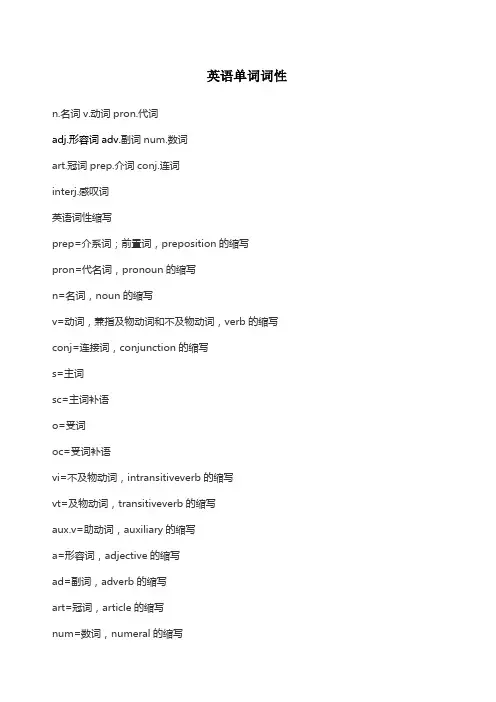
英语单词词性n.名词v.动词pron.代词adj.形容词adv.副词num.数词art.冠词prep.介词conj.连词interj.感叹词英语词性缩写prep=介系词;前置词,preposition的缩写pron=代名词,pronoun的缩写n=名词,noun的缩写v=动词,兼指及物动词和不及物动词,verb的缩写conj=连接词,conjunction的缩写s=主词sc=主词补语o=受词oc=受词补语vi=不及物动词,intransitiveverb的缩写vt=及物动词,transitiveverb的缩写aux.v=助动词,auxiliary的缩写a=形容词,adjective的缩写ad=副词,adverb的缩写art=冠词,article的缩写num=数词,numeral的缩写int=感叹词,interjection的缩写u=不可数名词,uncountablenoun的缩写c=可数名词,countablenoun的缩写pl=复数,plural的缩写语气词int.缩写词abbr.abbrabbreviation(略)略语adj,adjjadjective(s)(形)形容词adv,advvadverb(s)(副)副词advpartadverbialparticle(副接)副词接语auxauxiliary(助)助动词cncountablenoun(可数)可数名词conjconjunction(连)连接defartdefinitearticle(定冠)定冠词egforexample(例如)例如espespecially(尤指)尤指etcandtheothers(等)等等iewhichistosay(意即)意即indefartindefinitearticle(不定冠词)不定冠词infinfinitive(不定词)不定词intinterjection(感)感叹词nnoun(s)(名)名词negnegative(ly)(否定)否定的(地)partadjparticipialadjective(分形)分词形容词persperson(人称)人称perspronpersonalpronoun(人称代)人称代名词plplural(复)复数(的)pppastparticiple(过去分词)过去分词prefprefix(字首)字首preppreposition(al)(介词)介词,介系词,介词的pronpronoun(代)代名词ptpasttense(过去)过去式sbsomebody(某人)某人singsingular(单)单数(的)sthsomething(某事物)某物或某事suffsuffix(字尾)字尾ununcountablenoun(不可数)不可数名词USAmerica(n)(美)美国(的)vverb(s)(动)动词[VP]VerbPattern(动型)动词类型viverbintransitive(不及物动词)不及物动词vtverbtransitive(及物动词)及物动词除这十大类词之外,英语还另有判断词yes和no。
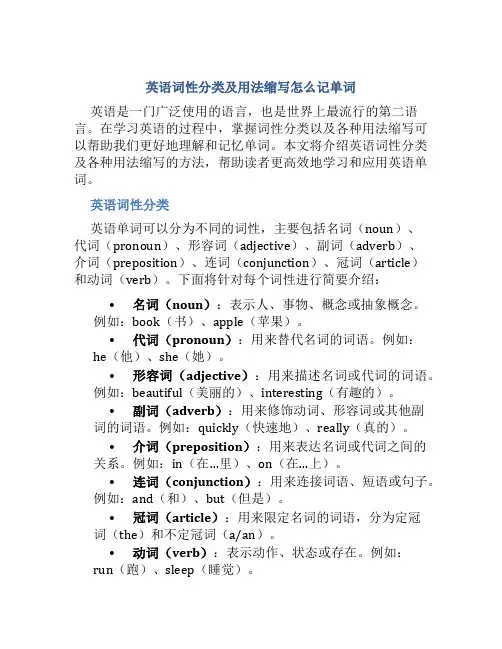
英语词性分类及用法缩写怎么记单词英语是一门广泛使用的语言,也是世界上最流行的第二语言。
在学习英语的过程中,掌握词性分类以及各种用法缩写可以帮助我们更好地理解和记忆单词。
本文将介绍英语词性分类及各种用法缩写的方法,帮助读者更高效地学习和应用英语单词。
英语词性分类英语单词可以分为不同的词性,主要包括名词(noun)、代词(pronoun)、形容词(adjective)、副词(adverb)、介词(preposition)、连词(conjunction)、冠词(article)和动词(verb)。
下面将针对每个词性进行简要介绍:•名词(noun):表示人、事物、概念或抽象概念。
例如:book(书)、apple(苹果)。
•代词(pronoun):用来替代名词的词语。
例如:he(他)、she(她)。
•形容词(adjective):用来描述名词或代词的词语。
例如:beautiful(美丽的)、interesting(有趣的)。
•副词(adverb):用来修饰动词、形容词或其他副词的词语。
例如:quickly(快速地)、really(真的)。
•介词(preposition):用来表达名词或代词之间的关系。
例如:in(在…里)、on(在…上)。
•连词(conjunction):用来连接词语、短语或句子。
例如:and(和)、but(但是)。
•冠词(article):用来限定名词的词语,分为定冠词(the)和不定冠词(a/an)。
•动词(verb):表示动作、状态或存在。
例如:run(跑)、sleep(睡觉)。
掌握这些基本的词性分类对于理解英语单词在句子中的作用非常重要。
下面将介绍一些记忆用法缩写的技巧。
用法缩写记单词为了更好地记忆单词的用法,我们可以利用缩写来帮助记忆。
下面是一些常见的用法缩写及其含义:•n.:名词(noun)的缩写。
表示该单词是一个名词,例如:cat(猫)。
•pron.:代词(pronoun)的缩写。
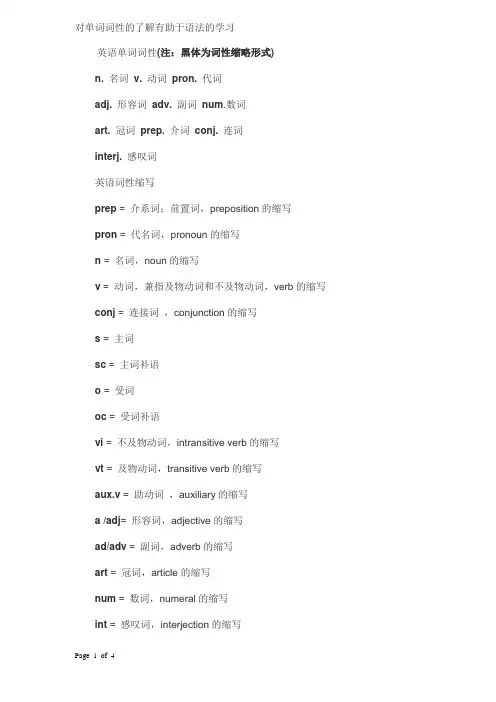
对单词词性的了解有助于语法的学习英语单词词性(注:黑体为词性缩略形式)n. 名词v.动词pron.代词adj. 形容词adv.副词num.数词art.冠词prep.介词conj. 连词interj. 感叹词英语词性缩写prep = 介系词;前置词,preposition的缩写pron = 代名词,pronoun的缩写n = 名词,noun的缩写v = 动词,兼指及物动词和不及物动词,verb的缩写conj = 连接词,conjunction的缩写s = 主词sc = 主词补语o = 受词oc = 受词补语vi = 不及物动词,intransitive verb的缩写vt = 及物动词,transitive verb的缩写aux.v = 助动词,auxiliary的缩写a /adj= 形容词,adjective的缩写ad/adv = 副词,adverb的缩写art = 冠词,article的缩写num = 数词,numeral的缩写int = 感叹词,interjection的缩写u = 不可数名词,uncountable noun的缩写c = 可数名词,countable noun的缩写pl = 复数,plural的缩写语气词int.缩写词abbr.abbr abbreviation(略)略语adj, adjjadjective(s)(形)形容词adv, advvadverb(s)(副)副词adv partadverbial particle(副接)副词接语aux auxiliary(助)助动词cn countable noun(可数)可数名词conj conjunction(连)连接def art definite article(定冠)定冠词eg./egfor example(例如)例如esp especially(尤指)尤指etc and the others(等)等等ie which is to say(意即)意即indef art indefinite article(不定冠词)不定冠词inf infinitive(不定词)不定词int interjection(感)感叹词n noun(s) (名)名词neg negative(ly)(否定)否定的(地)part adj participial adjective(分形)分词形容词pers person(人称)人称pers pron personal pronoun(人称代)人称代名词pl plural(复)复数(的)pp past participle (过去分词)过去分词pref prefix(字首)字首prep preposition(al) (介词)介词,介系词,介词的pron pronoun (代)代名词pt past tense(过去)过去式sb somebody(某人)某人sing singular(单)单数(的)sth something(某事物)某物或某事suff suffix(字尾)字尾un uncountable noun(不可数)不可数名词US America(n)(美)美国(的)v.verb(s) (动)动词[VP]Verb Pattern(动型)动词类型vi .verb intransitive(不及物动词)不及物动词vt. verb transitive (及物动词)及物动词除这十大类词之外,英语还另有判断词yes和no。
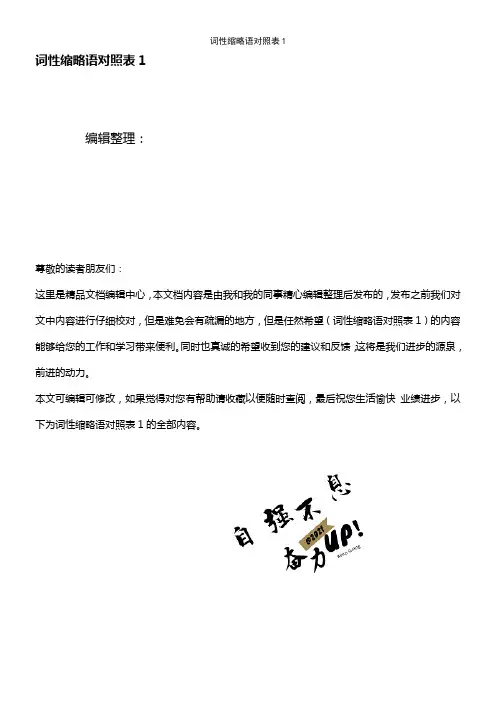
词性缩略语对照表1
编辑整理:
尊敬的读者朋友们:
这里是精品文档编辑中心,本文档内容是由我和我的同事精心编辑整理后发布的,发布之前我们对文中内容进行仔细校对,但是难免会有疏漏的地方,但是任然希望(词性缩略语对照表1)的内容能够给您的工作和学习带来便利。
同时也真诚的希望收到您的建议和反馈,这将是我们进步的源泉,前进的动力。
本文可编辑可修改,如果觉得对您有帮助请收藏以便随时查阅,最后祝您生活愉快业绩进步,以下为词性缩略语对照表1的全部内容。
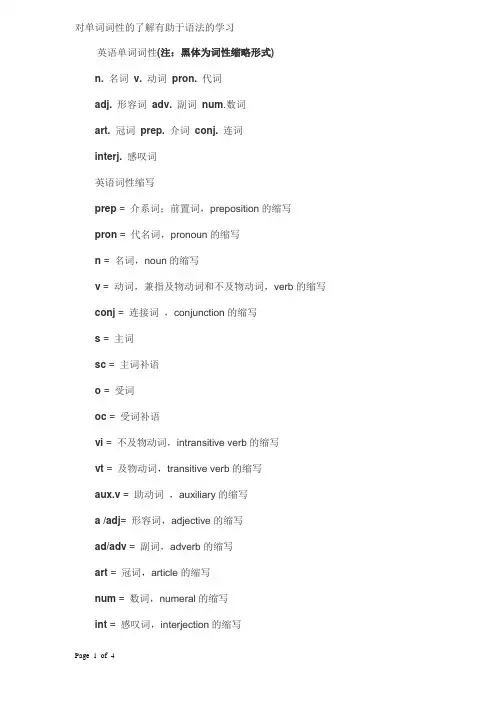
对单词词性的了解有助于语法的学习英语单词词性(注:黑体为词性缩略形式)n. 名词v.动词pron.代词adj. 形容词adv.副词num.数词art.冠词prep.介词conj. 连词interj. 感叹词英语词性缩写prep = 介系词;前置词,preposition的缩写pron = 代名词,pronoun的缩写n = 名词,noun的缩写v = 动词,兼指及物动词和不及物动词,verb的缩写conj = 连接词,conjunction的缩写s = 主词sc = 主词补语o = 受词oc = 受词补语vi = 不及物动词,intransitive verb的缩写vt = 及物动词,transitive verb的缩写aux.v = 助动词,auxiliary的缩写a /adj= 形容词,adjective的缩写ad/adv = 副词,adverb的缩写art = 冠词,article的缩写num = 数词,numeral的缩写int = 感叹词,interjection的缩写u = 不可数名词,uncountable noun的缩写c = 可数名词,countable noun的缩写pl = 复数,plural的缩写语气词int.缩写词abbr.abbr abbreviation(略)略语adj, adjjadjective(s)(形)形容词adv, advvadverb(s)(副)副词adv partadverbial particle(副接)副词接语aux auxiliary(助)助动词cn countable noun(可数)可数名词conj conjunction(连)连接def art definite article(定冠)定冠词eg./egfor example(例如)例如esp especially(尤指)尤指etc and the others(等)等等ie which is to say(意即)意即indef art indefinite article(不定冠词)不定冠词inf infinitive(不定词)不定词int interjection(感)感叹词n noun(s) (名)名词neg negative(ly)(否定)否定的(地)part adj participial adjective(分形)分词形容词pers person(人称)人称pers pron personal pronoun(人称代)人称代名词pl plural(复)复数(的)pp past participle (过去分词)过去分词pref prefix(字首)字首prep preposition(al) (介词)介词,介系词,介词的pron pronoun (代)代名词pt past tense(过去)过去式sb somebody(某人)某人sing singular(单)单数(的)sth something(某事物)某物或某事suff suffix(字尾)字尾un uncountable noun(不可数)不可数名词US America(n)(美)美国(的)v.verb(s) (动)动词[VP]Verb Pattern(动型)动词类型vi .verb intransitive(不及物动词)不及物动词vt. verb transitive (及物动词)及物动词除这十大类词之外,英语还另有判断词yes和no。
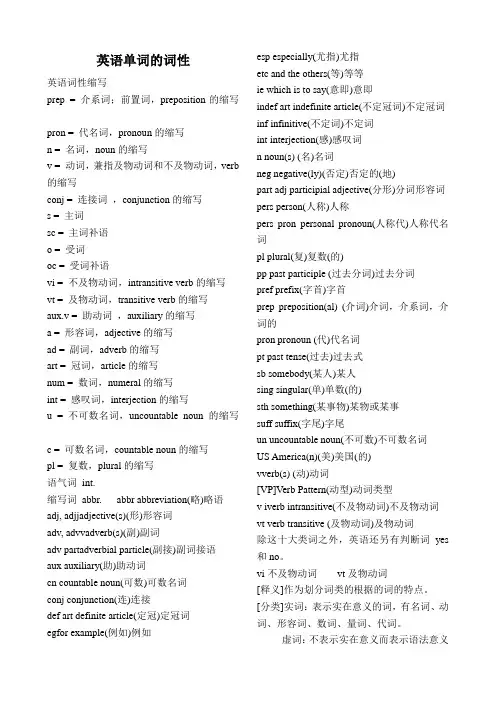
英语单词的词性英语词性缩写prep = 介系词;前置词,preposition的缩写pron = 代名词,pronoun的缩写n = 名词,noun的缩写v = 动词,兼指及物动词和不及物动词,verb 的缩写conj = 连接词,conjunction的缩写s = 主词sc = 主词补语o = 受词oc = 受词补语vi = 不及物动词,intransitive verb的缩写 vt = 及物动词,transitive verb的缩写aux.v = 助动词,auxiliary的缩写a = 形容词,adjective的缩写ad = 副词,adverb的缩写art = 冠词,article的缩写num = 数词,numeral的缩写int = 感叹词,interjection的缩写u = 不可数名词,uncountable noun的缩写c = 可数名词,countable noun的缩写pl = 复数,plural的缩写语气词int.缩写词abbr. abbr abbreviation(略)略语adj, adjjadjective(s)(形)形容词adv, advvadverb(s)(副)副词adv partadverbial particle(副接)副词接语 aux auxiliary(助)助动词cn countable noun(可数)可数名词conj conjunction(连)连接def art definite article(定冠)定冠词egfor example(例如)例如 esp especially(尤指)尤指etc and the others(等)等等ie which is to say(意即)意即indef art indefinite article(不定冠词)不定冠词inf infinitive(不定词)不定词int interjection(感)感叹词n noun(s) (名)名词neg negative(ly)(否定)否定的(地)part adj participial adjective(分形)分词形容词pers person(人称)人称pers pron personal pronoun(人称代)人称代名词pl plural(复)复数(的)pp past participle (过去分词)过去分词pref prefix(字首)字首prep preposition(al) (介词)介词,介系词,介词的pron pronoun (代)代名词pt past tense(过去)过去式sb somebody(某人)某人sing singular(单)单数(的)sth something(某事物)某物或某事suff suffix(字尾)字尾un uncountable noun(不可数)不可数名词 US America(n)(美)美国(的)vverb(s) (动)动词[VP]V erb Pattern(动型)动词类型v iverb intransitive(不及物动词)不及物动词vt verb transitive (及物动词)及物动词除这十大类词之外,英语还另有判断词yes 和no。
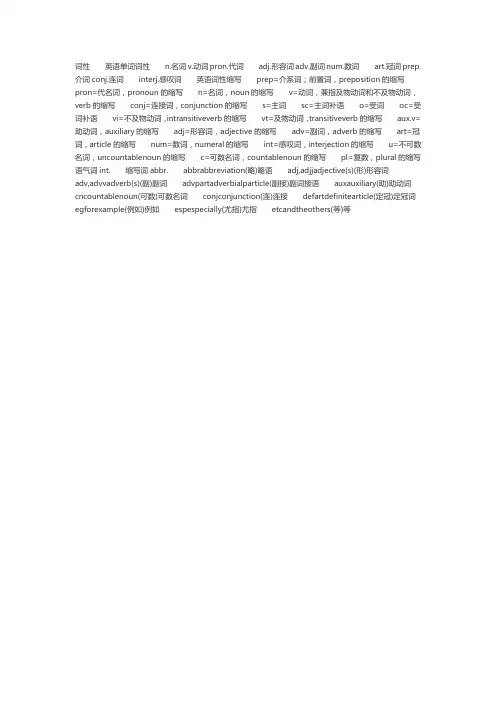
词性英语单词词性n.名词v.动词pron.代词adj.形容词adv.副词num.数词art.冠词prep.介词conj.连词interj.感叹词英语词性缩写prep=介系词;前置词,preposition的缩写pron=代名词,pronoun的缩写n=名词,noun的缩写v=动词,兼指及物动词和不及物动词,verb的缩写conj=连接词,conjunction的缩写s=主词sc=主词补语o=受词oc=受词补语vi=不及物动词,intransitiveverb的缩写vt=及物动词,transitiveverb的缩写aux.v=助动词,auxiliary的缩写adj=形容词,adjective的缩写adv=副词,adverb的缩写art=冠词,article的缩写num=数词,numeral的缩写int=感叹词,interjection的缩写u=不可数名词,uncountablenoun的缩写c=可数名词,countablenoun的缩写pl=复数,plural的缩写语气词int. 缩写词abbr. abbrabbreviation(略)略语adj,adjjadjective(s)(形)形容词
adv,advvadverb(s)(副)副词advpartadverbialparticle(副接)副词接语auxauxiliary(助)助动词cncountablenoun(可数)可数名词conjconjunction(连)连接defartdefinitearticle(定冠)定冠词egforexample(例如)例如espespecially(尤指)尤指etcandtheothers(等)等。
英语单词词性大全英语单词词性n. 名词 v. 动词 pron. 代词adj. 形容词 adv. 副词 num.数词art. 冠词 prep. 介词 conj. 连词interj. 感叹词英语词性缩写prep = 介系词;前置词,preposition的缩写pron = 代名词,pronoun的缩写n = 名词,noun的缩写v = 动词,兼指及物动词和不及物动词,verb的缩写conj = 连接词,conjunction的缩写s = 主词 sc = 主词补语 o = 受词oc = 受词补语vi = 不及物动词,intransitive verb的缩写vt = 及物动词,transitive verb的缩写aux.v = 助动词,auxiliary的缩写a = 形容词,adjective的缩写ad = 副词,adverb的缩写art = 冠词,article的缩写num = 数词,numeral的缩写int = 感叹词,interjection的缩写u = 不可数名词,uncountable noun的缩写c = 可数名词,countable noun的缩写pl = 复数,plural的缩写语气词 int. 缩写词 abbr.abbr abbreviation(略)略语adj, adjjadjective(s)(形)形容词adv, advvadverb(s)(副)副词adv partadverbial particle(副接)副词接语aux auxiliary(助)助动词cn countable noun(可数)可数名词conj conjunction(连)连接def art definite article(定冠)定冠词egfor example(例如)例如esp especially(尤指)尤指etc and the others(等)等等 ie which is to say(意即)意即indef art indefinite article(不定冠词)不定冠词inf infinitive(不定词)不定词int interjection(感)感叹词n noun(s) (名)名词neg negative(ly)(否定)否定的(地)part adj participial adjective(分形)分词形容词pers person(人称)人称pers pron personal pronoun(人称代)人称代名词pl plural(复)复数(的)pp past participle (过去分词)过去分词pref prefix(字首)字首prep preposition(al) (介词)介词,介系词,介词的pron pronoun (代)代名词pt past tense(过去)过去式sb somebody(某人)某人sing singular(单)单数(的)sth something(某事物)某物或某事suff suffix(字尾)字尾un uncountable noun(不可数)不可数名词US America(n)(美)美国(的)vverb(s) (动)动词[VP]Verb Pattern(动型)动词类型v iverb intransitive(不及物动词)不及物动词vt verb transitive (及物动词)及物动词除这十大类词之外,英语还另有判断词yes和no。
prep. = 介系词(介词);前置词,preposition的缩写
pron.=代名词(代词),pronoun的缩写
n.=名词,noun的缩写
v. = 动词,兼指及物动词和不及物动词,verb的缩写
conj. = 连接词,conjunction的缩写
s= 主词(主语)
sc= 主词补语(有两种说法,一种表示主语补语=表语,一种表示一般表语属于主语补语)
o= 受词(宾语)
oc= 受词补语(宾补)
vi.=不及物动词,intransitive verb的缩写
vt.=及物动词,transitive verb的缩写
aux.v= 助动词,auxiliary的缩写
adj.=形容词,adjective的缩写
adv.=副词,adverb的缩写
art.=冠词,article的缩写
num.=数词,numeral的缩写
int.=感叹词,interjection的缩写
u.=不可数名词,uncountable noun的缩写
c.=可数名词,countable noun的缩写
pl.=复数,plural的缩写